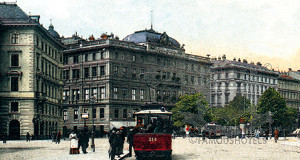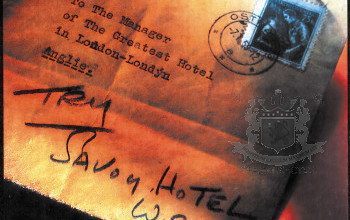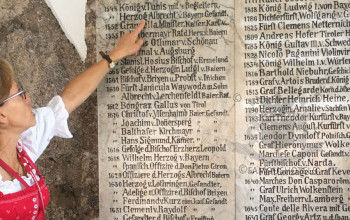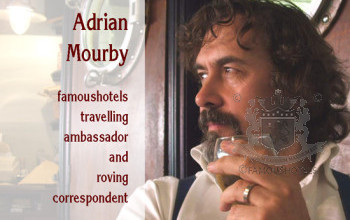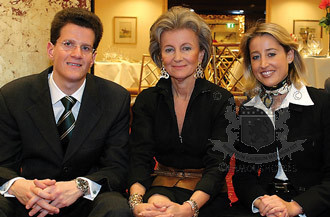1975: Luxury Hotel Keeping — Imperial Vienna
( words)
The Hotel Imperial in Vienna is a monument to aristocratic Belle Epoque Europe. The hotel was built in 1867 and was one of the new buildings on the Ringstrasse, the city's new Boulevard.
The hotel was originally constructed by the Duke of Wurttemberg as a town palace, but when the Vienna City Council built a road behind the palace, the duke, offended, never set foot there again. When in 1873 the International Exhibition was staged in Vienna, the palace was converted into a luxury hotel and soon earned the title 'By Royal Appointment.' The Emperor's guests stayed there, rather than at the Hotel Sacher, where the Crown Prince and his set entertained their actress friends, and where Frau Sacher, a formidable cigar smoking matron reigned, oblivious to official disapproval.
The hotel's history reads like a page of the history of Europe. Richard Wagner stayed there; the assassination of Archduke Ferdinand at Sarajevo and Ribbentrop's invasion of Yugoslavia in 1940 were planned there, and after the Second World War the Russians, in residence, roasted oxen in the guest lounge. The in 1955 Austria became independent and the Imperial re-opened in all its former glory. The facade of the hotel, painted in Imperial Habsburg yellow, is in classical Renaissance style, with pilasters, pediment and frieze, massive caryatids, and neo-baroque details. Inside, a magnificent staircase of red, yellow and black marble is supported by classical columns and balustrades and overlooked by statues of reclining gods and majestic goddesses. The staircase, embellished by coats of arms and chandeliers, is crowned by a gilded balcony where the emperor greeted his guests.
The hotel, which has a guest capacity of 300, has 160 rooms, including 13 apartments and four junior suites, with coffered wedding cake ceilings and ballroom-size salons. Rooms and corridors are lavishly furnished with antiques, including Maria Theresa baroque commodes, cupboards and stoves. The bathrooms incorporate telephones, heated floors and thermostats which control the temperature of the bath water. Many guests recommend rooms to friends. One guest, delighted with room 331, recommended it to numerous friends, many of whom requested the room on identical dates. On the first floor there are two interconnecting State Apartments, comprising two sitting rooms, four double and one single bedroom. in which Queen Elizabeth II and the Duke of Edinburgh, President Kennedy, Mr Kruschev, Herr Brandt and Mr Wilson, among other dignitaries, have stayed. The lounge, richly decorated in white and gold marble, with balconies and balustrades, pilasters and friezes, accommodates up to 200 at a cocktail party and 100 at a conference. The main banqueting room, the Festsaal, with coffered ceilings, red curtains and Baccanhalian frescoes, accommodates 120 at a cocktail party and 80 at a banquet. The Gobelinsaal, on the mezzanine floor, accommodates 125 at a cocktail party and 50 at a banquet. The other main function room, the Marmorsaal, once the stables in the original palace, is decorated in Gothic and Romanesque manner, and accommodates up to 100 for a cocktail party and 60 for a banquet. The Imperial Director, Herr Karl-Peter Littig, supervised the re-opening of the hotel in 1955-57. Born in Munich, Herr Littig runs the hotel not only with the aid of stopwatches, colour cards and efficiency graphs and statistics, but also with a unique brand of enthusiasm and warmth. 'We try to create the atmosphere of a large private house,' says Littig. 'In many modern chain hotels organization is all important. At the Imperial the guest is all important. The staff look after the guests if the management looks after the staff. Of our staff of 340, over 50, mainly in middle-management, have been with the hotel since it reopened. 'Running a hotel means checking that telephones work, that soap is available in bathrooms, that guests have the kind of mattress they want and do not have to ask for it on their next visit. I love organisation and dislike improvisation.' When the guest checks in, the reception clerk presses several invisible buttons and before he reaches his room his identity has shot up in a pneumatic tube to the chambermaid, the valet and the floor waiter, and his luggage is waiting for him. Breakfast, served in the room, consists of coffee hot milk with whipped cream, butter, four kinds of marmalade, honey, kipferl, rolls, rye bread, pumpernickel, graham bread and melba toast. Room service is provided by waiters and there are no self-service minibars.
The Imperial is a hotel with a human face and personal contact with guests is paying its rewards during the current world recession. Some 65% of guests are regulars, 90% are individuals and 1/3 American. The room occupancy rate is currently 63% compared to 74% four years ago. Businessmen, who four years ago represented 40%, now represent 85%. Bookings now tend to be irregular and hectic, which makes planning more difficult, but business has to be accepted as it comes. The average length of stay, which used to be four days, is now two so that instead of, say, 40 people arriving and leaving the hotel every day, there may be 80. Guests once made room reservations months in advance but now wait until the last minute. The increase in turnover creates extra work for the staff, and the hotel may be quiet in the morning but busy in the afternoon. The hotel hosts all state visits, which generate valuable publicity but create security problems. The profits are not large because the banquets and receptions are usually held outside the hotel.
The clientele is political and industrial rather than show-business, because it is advisable to cater for one or the other but not both of these two worlds. Three years ago the hotel dispensed with the services of the only reservation system to which it belonged. 'The results did not justify the cost. When business is poor reservation systems tend to produce few bookings. When business is good and the hotel full, they produce too many,' says Herr Littig. Room sales produce 60% of the profit, the other 40% being provided by conferences and other departments. Restaurant and bar profits are marginal because a kitchen in a luxury hotel is an 18 hour a day operation and inevitably loses money. The main kitchen which is divided into the classic sections of sauciere, entremetier, gardemanger, boucherie and patisserie, has a staff of 50, including 25 trainees on a three-year apprenticeship. The preparation of the main base dishes is done during the day and in the evening a smaller brigade prepares ? la minute dishes. The menu, until recently changed every day, is now changed every two days, which has produced savings in food consumption, working hours, gas, electricity, and menu printing costs. A smaller kitchen, with three cooks, serves the hotel's caf?. The two kitchens serve an average 350 meals a day. If there are two sittings in both restaurants costs are covered. But four sittings are necessary to make a significant profit.
By buying food in bulk discounts can be obtained. 'Shopping around is essential and we never rely on one supplier,' says Herr Littig. 'Food manufacturers derive prestige from supplying a luxury hotel and wine merchants like to appear on the wine list. We spend about 25 million schillings a year on food, and obtain a 15% discount. On meat we spend four million schillings, and we have one supplier for filet, one for veal, one for pork and mutton. But waste on meat is high and if you provide the best quality meat you lose on it.' The hotel is supplied by some 60 food and beverage suppliers; there are, for example, three for game, two for sausages, five for fish, six for green vegetables, five for potatoes and six for chocolate. Herr Littig, the chef, the maitre d'hotel and the purchasing officer hold regular sampling sessions. Some five such sessions are held a year to sample coffee. Various brands are tasted, without the jury knowing any of the details of their manufacture or blend, and awarded marks for merit. 'In Vienna coffee is a religion,' says Herr Littig, 'and everybody knows what he likes. By mixing brands such as Meinl, Arabia and Haag we produce many different blends.' Tasting sessions are held twice a year for tea and in October wine tasting sessions are held to select 120 wines provided by some 20 suppliers. A luxury hotel must provide the best, and because the best food is expensive it is difficult to make a net profit on. The more expensive and item the less profit for the hotel. The restaurant must make a 100% gross profit to cover costs. Profits on wine are good, although profits on beer and whisky are limited because of taxes at almost 40%. A whisky in Vienna, for example, costs 1/3 more than in Munich or Zurich. 'The golden rules in hotel catering are portion control, price costing and prevention of waste,' says Herr Littig. 'It is not true that more business means more profit. If your price costing is wrong you lose more money serving 100 meals than 50. A luxury hotel must be luxurious at the front of the house but strictly economical behind the scenes. Inventory control must be carried out once a month, not only by the kitchen staff, but by the purchasing department. Food and beverage sales follow a general pattern throughout the year. December and January are quiet months, April is unprofitable because the first fresh vegetables, which are expensive, appear on the menu, and so on.'
The hotel's main restaurant consisting of three interconnecting rooms and a restaurant s?par?e, with a capacity of 80, is typically Viennese in its layout. A large space is divided into small rooms with intimate nooks and warmly upholstered corners, and yet the elegant style is maintained. The menu reflects the multinational recipes of the Austro-Hungarian Empire, and includes the goulashes of Hungary, the dumplings, doughs and savoury meats of Bohemia, the tortes of Budapest, and the breaded veal cutlets of Milan. Traditional Viennese dishes include Beuschl Stew with spices and pancakes filled with apricot jam. The hotel's caf? is in fact a brasseries and also consists of three interconnecting rooms, with a capacity of 170 and includes a pavement terrace under red and blue awnings known as the Schani Garden. According to Herr Littig this derives from the time honoured practice of the proprietor telling the waiter in Viennese slang: 'Schani, bring the garden in, it's raining.' The caf?, with upholstered chairs, marble top tables, superb pastries, and newspapers and magazines, is a popular rendez-vous for the musical and business worlds.' The initial restoration of the hotel in 1955 cost 90 million schillings and since then another 50 million schillings have been spent on annual renovation. The height of the ground floor enabled an extra mezzanine floor to created where the Gobelin Saal, the managerial and administrative offices and hairdressing salons are situated. Every year, between November and January, an entire floor is renovated. The cost of renovating some ten rooms on the first floor, which contains the State Apartments, was five million schillings.
The average life of a carpet is some seven years, a mattress ten years, bathroom fittings six years, a chairs and tables in guest rooms five years. Banqueting room furniture has a life of about eight years. The air conditioning system, manufactured by Westinghouse of Milan, was installed in all rooms. The central heating system uses the same pipes. The exterior of the hotel, including the highly wrought baroque facade is repainted every ten years in Habsburg Imperial yellow, which with ten men working three months, costs 2.5 millon schillings. The hotel has three guest lifts and one luggage lift. 'We need a fifth lift for staff, who should not use the same one as guests,' says Herr Littig. 'But a fifth lift would take up the space of ten rooms.' There are three automatic service lifts and service stations on each floor containing heating cupboards, washing up machines and large tables on wheels on which meals are served in rooms. 2/3 of breakfasts are served in rooms, and the remainder in the caf?. One of the differences between a good hotel and a luxury hotel is the quality of the room service.
(Published in 1975) famoushotels.org archives / t.cane

